
As technology advances, the way it’s integrated in sports’ training does as well. With strict testing rules this season in the Formula 4 United States Championship Powered by Honda, drivers were not allowed to test on tracks that the series competed at in 2017. So instead of stepping into a car to practice, some used virtual racing to supplement seat time.
Benjamin Pedersen of Copenhagen, Denmark, dominated the last two F4 U.S. events at Circuit of the Americas. Winning three of the five races jolted the Global Racing Group pilot in standings to claim second in the F4 U.S. FIA Championship points. His training efforts outside the car changed slightly by spending most of his time preparing for the steep elevation changes and tight COTA turns using advanced racing simulation.
“I spent hours analyzing the COTA track before I even did a real-life track walk or practice. After I visited COTA for the first time as a fan a few years ago, I was enamored with it,” Pedersen said. “I started practicing COTA on iRacing and on other video games like Forza before I even raced cars. I’ve spent hours virtually assessing the best way to pass on the track, where I can gain the best draft and even practicing starts. It started out as something fun I would do in my spare time, and then it transformed into a training tool. The time I spent on the simulator really helped me conquer this track and win my first ever race in F4 U.S.”
In his sophomore F4 U.S. season driving the tiger-striped DirtFish Rally car, Pedersen drastically improved over his rookie season, earning four fast laps, four pole positions and 12 top-10 finishes, six of which were podium finishes featuring three wins.
“Nothing replaces a great team, coaches, mechanics and engineers, and even they are a core part of the simulator work,” Pedersen continued. “I consulted and worked with my coaches during sim training and had them online to review my laps from across the country. In addition to this, we also had a good indication of ho we’d like to run our car setup based on the feedback I was receiving through the simulator, giving us a big advantage for the start of the real race weekend.”
Pedersen even earned two Cameron Das Fast Qualifier Awards presented by Pro-Sim.
Pro-Sim, a United Kingdom-based company at the forefront of motorsport simulations, sponsored the F4 U.S. Championship this past season by offering a contingency prize of $500 per event for the fastest qualifier and awarding a season-end grand prize of $2,000 to the competitor with the most overall fast lap times of the season.
Pro-Sim also committed to support the F4 U.S. inaugural champion Cameron Das in the UK by supplying a Formula 1 -simulator to prepare Das for the next step in his racing career. The commercial-grade racing simulator is built with authentic F1 equipment to accurately represent an F1 car.
“I started using simulators before I started racing, and it was with these programs I learned to drive a car,” said Das, who finished fifth in his rookie BRDC British F3 season. “Last year in preparation for British F3, I had a Pro-Sim installed in my house in England. It’s helped tremendously with getting up to speed on foreign tracks and a new car. My engineer was able to do some car development with it as well. I could do extensive testing on all the tracks I raced at during the year in the British F3 car model. The use of the sim massively expedited the learning process in free practice sessions because I more or less knew what would and wouldn’t work in real life. I typically spend a couple hours on the sim every day I have the opportunity and even more ahead of a race weekend. In the modern era, simulator usage is essential to success in motorsport.”
With the popularity of formula racing in the United States increasing, Pro-Sim anticipates entering the North American market in the upcoming years, offering drivers from club racing through touring cars, GTs, prototypes and even F1, specially developed simulation cars; which are carried out with maximum accuracy track models to accurately represent the driver’s car, ensuring the maximum value possible from the simulator session.
“Simulation training gives drivers access to extra seat time without having to travel and miss school for additional testing,” said Steve Oseth, SCCA Pro Racing vice president. “We’ve noticed that the drivers who use a simulator as part of their training, take less time to adapt to the new tracks. While testing and getting familiar with the actual car is important, racing simulators offer one more layer to driver development.”
With sports franchises like F1 and the NBA creating professional eSports leagues, the use of technology within developing sports will only continue to increase, offering additional outlets to gain fanbases and even cultivate potential athletes.






